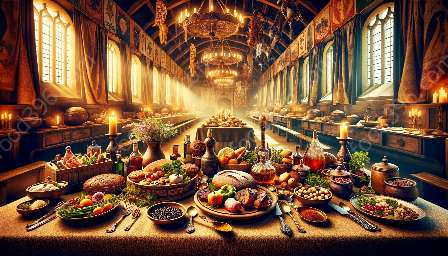Feasts and banquets in medieval society were elaborate and significant events that held cultural, social, and political importance. These grand gatherings were not merely about indulgence but also about showcasing wealth, power, and hospitality. In this exploration, we delve into the opulence and traditions of medieval feasts, their role in society, and their impact on culinary history.
The Significance of Feasts and Banquets
Feasts and banquets in medieval society were much more than just opportunities to indulge in extravagant food and drink. These events were a reflection of power, status, and communal celebration. The lavishness of a feast often served as a measure of one's wealth and influence, making them important occasions for nobility and royalty to display their opulence. Additionally, feasts were a means of social and political networking, where alliances were forged, disputes were resolved, and diplomacy was conducted amidst the sumptuous spread.
Key Elements of Medieval Feasts
Medieval feasts were characterized by a variety of sensory experiences, including intricate table settings, lively entertainment, and, of course, decadent cuisine. The visual display was paramount, with tables adorned with luxurious tableware, elaborate centerpieces, and decorative textiles. The scent of exotic spices, roasting meats, and freshly baked bread filled the air, while the sounds of music, laughter, and revelry contributed to the vibrant atmosphere.
The Feast Menu
The menu of a medieval feast often featured an array of dishes that showcased the culinary skill and abundance of the host. Roasted meats such as boar, venison, and fowl were commonly featured, alongside elaborate pies, pastries, and tarts. The use of spices such as cinnamon, nutmeg, and saffron added an exotic flavor to the dishes, reflecting the wealth and sophistication of the host.
Medieval Banquet Entertainment
Entertainment was a central component of medieval banquets, ranging from music and dancing to theatrical performances and juggling acts. Minstrels and troubadours regaled guests with musical performances, while jesters and acrobats provided amusement with their antics. The combination of sumptuous food and captivating entertainment created a truly immersive and memorable experience for all in attendance.
Medieval Cuisine and Culinary History
The culinary traditions of the medieval period were shaped by a blend of influences, including the availability of ingredients, trade routes, and cultural exchanges. The introduction of spices from the East, the cultivation of new crops, and the refinement of cooking techniques all played a role in shaping the evolution of medieval cuisine. Furthermore, the feasts and banquets of the time served as platforms for culinary innovation, as chefs and cooks sought to create impressive and inventive dishes to impress and delight their guests.
Legacy of Medieval Feasts
The legacy of medieval feasts and banquets extends beyond the opulence and indulgence of the events themselves. These gatherings contributed to the development of culinary arts, the exchange of culinary knowledge, and the cultivation of gastronomic appreciation. The enduring impact of medieval cuisine on subsequent culinary traditions is evident in the continued use of certain ingredients, cooking methods, and culinary customs that trace their roots back to this illustrious era.

